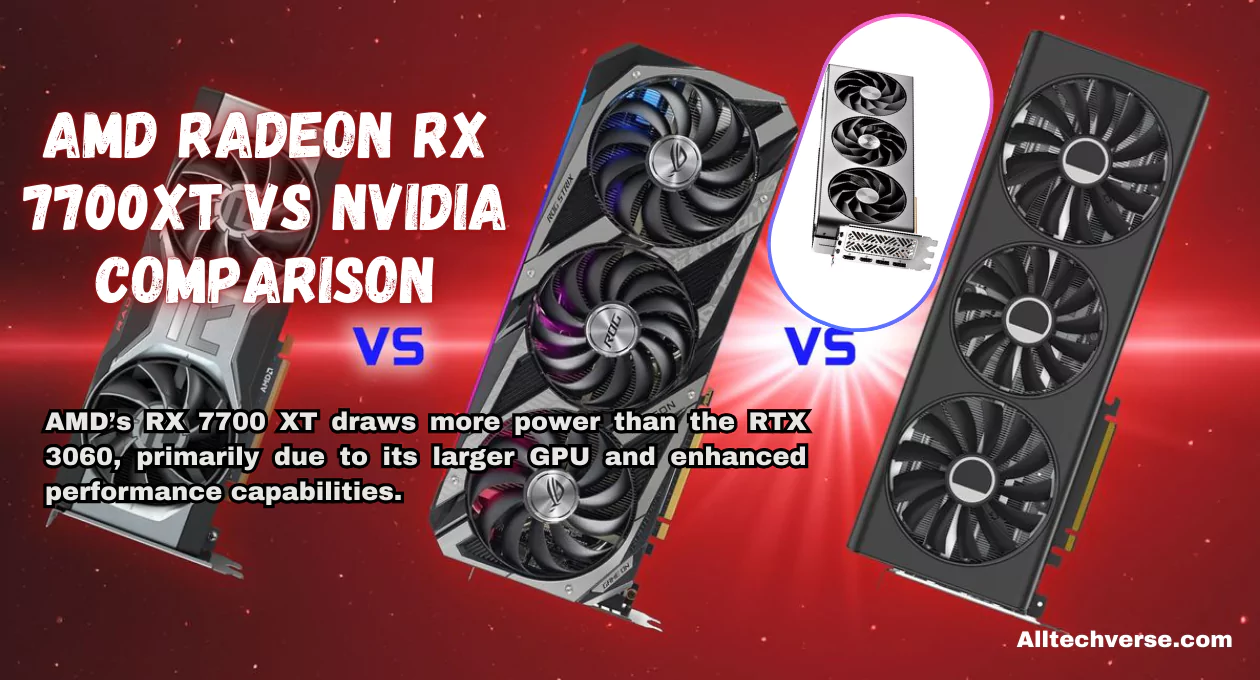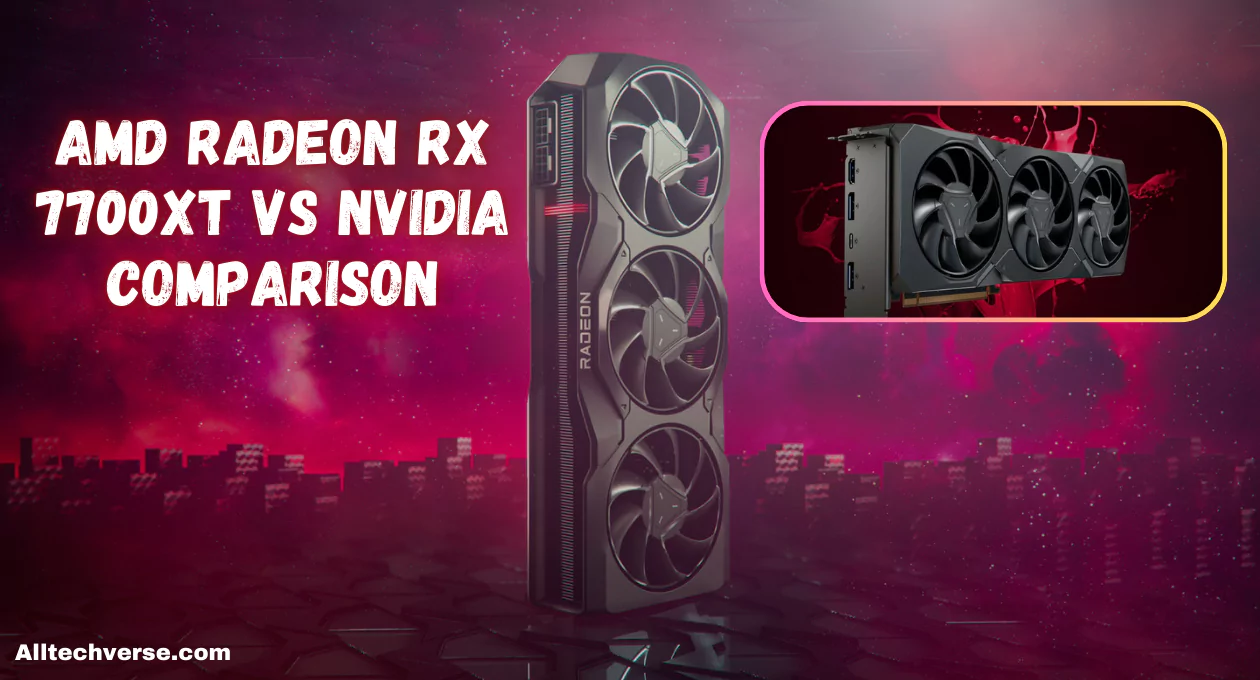The battle between AMD and Nvidia in the graphics card market remains fierce, with each new release sparking comparisons. The AMD Radeon RX 7700 XT has recently been pitted against Nvidia’s lineup, including the RTX 3060 Ti, RTX 3070, and RTX 4070. In this blog, we’ll break down the amd radeon rx 7700xt vs nvidia comparison, from gaming benchmarks to power consumption and future-proofing potential.
When it comes to gaming performance, the Radeon RX 7700 XT holds its own against Nvidia’s mid-range options, often delivering superior frame rates in DirectX 12 and Vulkan-supported games. On the other hand, Nvidia’s RTX cards typically offer more consistent performance in ray tracing, thanks to their dedicated hardware capabilities. As both AMD and Nvidia continue to release driver updates, each card’s performance might improve, making them viable options for different types of gamers.
AMD Radeon RX 7700 XT vs Nvidia RTX 3070
The RX 7700 XT and RTX 3070 are designed for high-quality 1440p gaming. While the RTX 3070 leverages Nvidia’s established architecture, AMD’s RDNA 3 architecture offers competitive performance and power efficiency. Gamers looking for real-time ray tracing should consider Nvidia’s long-standing leadership in this area. However, the RX 7700 XT provides robust performance, especially at a similar price point.
In terms of power consumption, the RX 7700 XT is slightly more efficient compared to the RTX 3070, which can be a critical factor for gamers conscious of their system’s energy use. While both cards pack a punch in performance, choosing the right option often comes down to personal preference and specific gaming needs. Additionally, the future support with software updates from either AMD or Nvidia may tip the scales toward one brand as new games and technologies emerge.
RX 7700 XT vs RTX 3060 Ti Performance
When compared to the RTX 3060 Ti, the RX 7700 XT generally offers superior performance. This gap becomes more apparent in higher resolution settings like 1440p, where AMD’s card excels. The 7700 XT is better suited for those seeking high-frame-rate gaming without compromise.
RX 7700 XT vs RTX 4070 Benchmarks
The RX 7700 XT and RTX 4070 are both powerful cards, but benchmarks highlight Nvidia’s advantage in ray tracing and AI-accelerated tasks. However, in raw rasterization performance, the RX 7700 XT often keeps up or even surpasses in specific gaming titles, making it a viable alternative for non-RT-heavy titles.
RX 7700 XT vs RTX 3060 Power Consumption
AMD’s RX 7700 XT draws more power than the RTX 3060, primarily due to its larger GPU and enhanced performance capabilities. Nvidia’s cards are generally recognized for power efficiency, and in this case, the RTX 3060 aligns well with low-power systems.

One crucial aspect to consider when choosing between these cards is the ecosystem support, particularly in terms of available technological advancements and software compatibility. Nvidia’s RTX cards benefit from features like DLSS, which enhances game performance and quality through AI upscaling. Meanwhile, AMD has targeted similar territory with their FidelityFX Super Resolution, which seeks to optimize gaming experiences, though it remains slightly less mature in comparison. This continuously evolving landscape emphasizes the importance of staying informed about updates from both manufacturers, as ongoing improvements can significantly affect the overall user experience.
RX 7700 XT vs RTX 3070 Price Comparison
While the RX 7700 XT and RTX 3070 are closely priced, the RX 7700 XT often comes in slightly lower. This lower cost can make AMD’s offering more attractive, especially for those prioritizing performance over ray tracing.
RX 7700 XT vs RTX 3060 Ti Ray Tracing
The RX 7700 XT supports ray tracing, but Nvidia’s RTX 3060 Ti provides a more refined experience. Nvidia’s extensive work on ray tracing means the RTX cards handle it better, although AMD’s FSR (FidelityFX Super Resolution) provides alternatives for better frame rates.
While navigating the competitive landscape of graphics cards, prospective buyers should carefully assess their specific gaming needs and budget constraints. The RX 7700 XT presents itself as a robust contender, particularly for gamers focused on high-performance rasterization at competitive pricing. Conversely, those keen on cutting-edge technologies like ray tracing might find more value in Nvidia’s RTX offerings, given their renowned efficiency and advanced features.
RX 7700 XT vs RTX 4070 DLSS vs FSR
Nvidia’s DLSS (Deep Learning Super Sampling) and AMD’s FSR are both designed to improve gaming visuals without compromising frame rates. DLSS tends to outperform FSR in terms of quality and integration, particularly with its AI-driven approach. AMD’s FSR is competitive, especially in games optimized for it.
Comparing the RX 7700 XT and Nvidia RTX series reveals a balance between performance and feature sets tailored to diverse gamer preferences. Those seeking raw power at a competitive price often lean towards AMD, while users prioritizing advanced technologies like ray tracing and AI enhancements might favor Nvidia. As gaming and graphical demands continue to evolve, keeping an eye on software updates and future releases is key to maximizing the potential of any choice.
RX 7700 XT vs RTX 3060 VRAM Capacity
The RX 7700 XT boasts 12GB of VRAM, more than the RTX 3060’s 8GB, which benefits high-resolution textures and future-proofing for upcoming games. Higher VRAM ensures better performance in demanding titles and future-proofing for resource-heavy applications.
RX 7700 XT vs RTX 3070 Gaming Performance
In gaming performance, the RX 7700 XT competes effectively with the RTX 3070. The RX 7700 XT shines particularly in DirectX 12 and Vulkan games, with competitive frame rates and stability.
RX 7700 XT vs RTX 3060 Ti 1440p Benchmarks
Benchmarks for 1440p resolution show that the RX 7700 XT outperforms the RTX 3060 Ti across various titles. This makes the RX 7700 XT a preferable option for 1440p gaming, where it consistently delivers high frame rates.
While comparing these graphics cards, it’s essential to understand the impact of driver support on gaming performance. Drivers can play a significant role in optimizing game compatibility and stability, ensuring that users receive the best possible experience. Regular updates from AMD and Nvidia often bring enhancements that improve frame rates and graphical fidelity, providing gamers with ongoing improvements long after the initial purchase.
RX 7700 XT vs RTX 4070 4K Performance
At 4K resolution, both the RX 7700 XT and RTX 4070 struggle to consistently hit high frame rates. Nvidia’s advantage in AI-driven upscaling (DLSS) makes the RTX 4070 a better option for 4K gaming, while the RX 7700 XT holds up in less intensive titles.
RX 7700 XT vs RTX 3060 Overclocking Potential
The RX 7700 XT offers decent overclocking headroom, though Nvidia’s RTX 3060 can be more stable under extreme overclocking. Enthusiasts looking for high overclocking performance might still favor Nvidia.
RX 7700 XT vs RTX 3070 Driver Support
Both AMD and Nvidia have strong driver support, though Nvidia’s GeForce Experience offers more streamlined updates. AMD has improved significantly in this regard, ensuring stability and performance optimization.
RX 7700 XT vs RTX 3060 Ti Availability
Both the RX 7700 XT and RTX 3060 Ti have faced supply challenges, though AMD’s 7000 series cards have generally seen better availability. Buyers may find the RX 7700 XT easier to acquire.
Both the RX 7700 XT and RTX 3060 Ti present appealing options for gamers, balancing price and performance. Enthusiasts must consider availability and future-proofing in their decision-making process. By weighing the advantages of each, gamers can select a card that aligns with their specific needs and preferences.
RX 7700 XT vs RTX 4070 Cooling Solutions
Cooling design is critical in graphics cards. The RX 7700 XT and RTX 4070 both offer efficient cooling, though Nvidia’s custom cooling designs are often quieter. AMD’s design still performs well, but may run slightly warmer under heavy load.
RX 7700 XT vs RTX 3060 Power Efficiency
Nvidia has a slight edge in power efficiency, especially with the RTX 3060, which is built for low-power systems. However, AMD’s advancements in RDNA 3 have narrowed this gap significantly.
When choosing between the RX 7700 XT and its Nvidia counterparts, aesthetics and personal brand loyalty can also influence purchasing decisions. Some users prefer the sleek designs and customizable RGB lighting options available with many Nvidia cards, while others appreciate AMD’s straightforward, robust build quality. Ultimately, the choice may come down to not just performance or price, but the overall appeal and brand experience, making personal preference an important factor in the final decision.
RX 7700 XT vs RTX 3070 Future-Proofing
With its 12GB VRAM, the RX 7700 XT has a future-proofing edge over the 8GB in the RTX 3070. Upcoming titles that demand high VRAM will perform better on the RX 7700 XT, although the RTX 3070 remains competitive in AI and ray tracing advancements.
RX 7700 XT vs RTX 3060 Ti Productivity Performance
In productivity tasks, Nvidia’s architecture typically performs better, particularly with software optimized for CUDA cores. The RX 7700 XT, however, still provides good performance for general-purpose tasks and light workstation use.
RX 7700 XT vs RTX 4070 AI Features
Nvidia’s RTX 4070 is superior in AI-driven tasks, with support for deep learning and accelerated performance in creative applications. While AMD’s RX 7700 XT has improved, Nvidia’s focus on AI remains unmatched.
RX 7700 XT vs RTX 3060 Price-to-Performance Ratio
AMD’s RX 7700 XT generally offers a better price-to-performance ratio compared to the RTX 3060, especially for those focused on rasterization over ray tracing. For budget-conscious gamers, the RX 7700 XT is a compelling choice.
FAQs about AMD Radeon rx 7700xt vs Nvidia comparison
1. Is the RX 7700 XT a good choice for gaming at high resolutions?
Yes, the RX 7700 XT performs well at 1440p resolution and offers competitive performance for 4K gaming in less demanding titles. Its 12GB VRAM makes it suitable for future-proofing against high-resolution textures.
2. How does the RX 7700 XT compare to the RTX series in terms of cooling?
Both the RX 7700 XT and Nvidia’s RTX series offer efficient cooling solutions. However, Nvidia’s custom cooling designs tend to be quieter, while AMD’s design may run slightly warmer under heavy load.
3. What are the benefits of higher VRAM in the RX 7700 XT?
Higher VRAM, such as the 12GB in the RX 7700 XT, enhances performance with high-resolution textures and supports future games and applications that require more memory for optimal performance.
4. Can the RX 7700 XT be overclocked effectively?
The RX 7700 XT has decent overclocking potential, though Nvidia’s RTX 3060 may provide more stability under extreme overclocking conditions. It is suitable for enthusiasts looking for moderate overclocking performance.
5. Is there a significant difference in driver support between AMD and Nvidia?
Both AMD and Nvidia have substantial driver support. Nvidia’s GeForce Experience provides more streamlined updates, though AMD has improved stability and performance optimization with recent iterations.
Conclusion
Both the AMD Radeon RX 7700 XT and Nvidia’s RTX series offer excellent options across a range of performance needs. While Nvidia shines in ray tracing and AI-driven tasks, AMD provides competitive performance, especially at higher resolutions. Whether choosing AMD or Nvidia, gamers and content creators have access to powerful, capable hardware suited for different priorities. For those prioritizing VRAM and raw gaming performance, the RX 7700 XT is a solid option, whereas Nvidia’s cards are better suited for ray tracing and AI-related applications.
In conclusion, when deciding between the RX 7700 XT and Nvidia’s offerings, it comes down to individual needs and preferences. AMD provides excellent value for gamers prioritizing VRAM and straightforward gaming performance. Meanwhile, Nvidia’s advanced features in AI and ray tracing cater to content creators and tech enthusiasts, ensuring a robust overall experience.
For more amazing information keep visiting Alltechverse.



